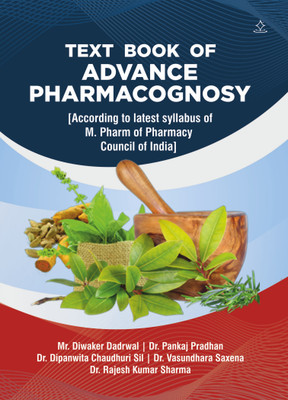TEXT BOOK OF ADVANCE PHARMACOGNOSY - According to latest syllabus of M. Pharm of Pharmacy Council of India(Paperback, Mr Diwaker Dadrwal, Dr. Pankaj Pradhan, Dr. Dipanwita Chaudhuri, Dr. Vasundhara Saxena, Dr. Rajesh Kumar)
Quick Overview
Product Price Comparison
The Text Book of Advance Pharmacognosy is a comprehensive academic resource that delves into modern developments and specialized topics in the field of pharmacognosy, with a particular emphasis on medicinal plants, marine natural products, nutraceuticals, phytopharmaceuticals, and pharmacovigilance. It begins with Plant Drug Cultivation, highlighting the pivotal role of pharmacognosy in the herbal drug industry, and covers the contributions of the Indian Council of Agricultural Research (ICAR), along with Current Good Agricultural, Cultivation, and Collection Practices essential for ensuring quality and sustainability. The section also discusses conservation strategies for medicinal plants, both ex-situ and in-situ, to preserve biodiversity. The second chapter explores Marine Natural Products, detailing general methods for isolation and purification, the study of marine toxins, and recent advances in marine drug research. It also addresses challenges such as taxonomical identification and chemical screening, along with their practical solutions. The third chapter on Nutraceuticals examines current trends, future prospects, and the therapeutic significance of various classes, including inorganic mineral and vitamin supplements, digestive enzymes, dietary fibers, cereals, grains, natural health drinks, antioxidants, polyunsaturated fatty acids, and herbs as functional foods. It also provides guidelines for formulation, standardization, and regulatory compliance under FSSAI norms. A dedicated section elaborates on Nutraceutical Sources, listing marker compounds, their chemical nature, medicinal uses, and health benefits for key examples like spirulina, soybean, ginseng, garlic, broccoli, green and herbal tea, flax seeds, black cohosh, and turmeric. The book then transitions into Phytopharmaceuticals, describing occurrence, isolation techniques, chemical characteristics, pharmacological applications, and health benefits of bioactive compounds such as carotenoids, limonoids, saponins, flavonoids, phenolic acids, vitamins, tocotrienols, tocopherols, andrographolide, glycolipids, gugulipids, withanolides, vascine, and taxol. The final chapter emphasizes Pharmacovigilance of Natural Drugs, discussing WHO and AYUSH guidelines for safety monitoring, spontaneous reporting schemes for adverse reactions, and critical insights into biodrugŌĆōdrug and biodrugŌĆōfood interactions with relevant examples. Overall, the book blends traditional pharmacognosy principles with cutting-edge research, regulatory frameworks, and applied aspects, making it a vital reference for students, researchers, and professionals in the pharmaceutical sciences.

